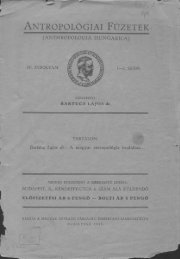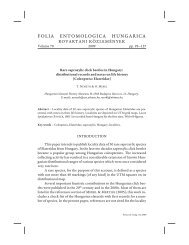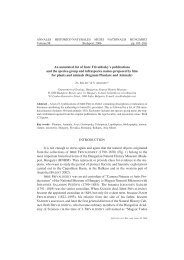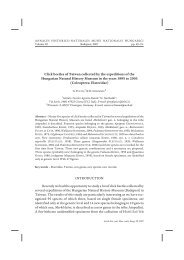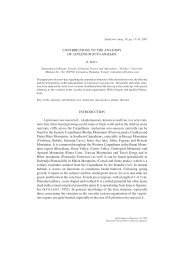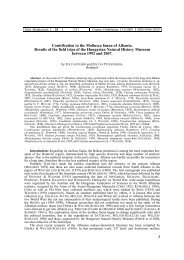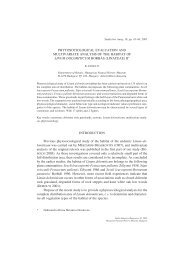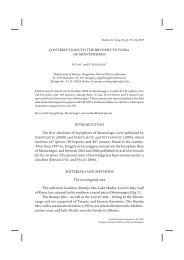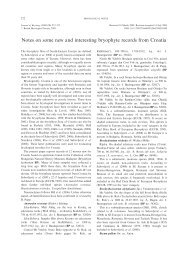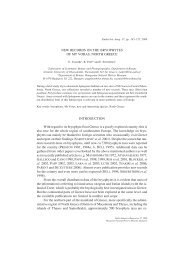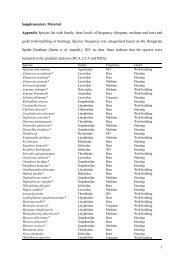THE GENUS SCHISTIDIUM (GRIMMIACEAE, MUSCI) IN HUNGARY ...
THE GENUS SCHISTIDIUM (GRIMMIACEAE, MUSCI) IN HUNGARY ...
THE GENUS SCHISTIDIUM (GRIMMIACEAE, MUSCI) IN HUNGARY ...
Create successful ePaper yourself
Turn your PDF publications into a flip-book with our unique Google optimized e-Paper software.
<strong>THE</strong> <strong>GENUS</strong> <strong>SCHISTIDIUM</strong> <strong>IN</strong> <strong>HUNGARY</strong> 31<br />
Robustum group: S. dupretii (Thér.) W. A. Weber, S. robustum (Nees<br />
et Hornsch.) H. H. Blom;<br />
Confertum group: S. confertum (Funck) Bruch et Schimp., S. flaccidum<br />
(De Not.) Ochyra;<br />
Atrofuscum group: S. brunnescens Limpr. subsp. brunnescens, S. brunnescens<br />
subsp. griseum (Nees et Hornsch.) H. H. Blom, S. crassipilum H. H.<br />
Blom, S. elegantulum H. H. Blom, S. helveticum (Schkuhr) Deguchi (= S. singarense<br />
(Schiffn.) Laz.).<br />
Historical aspects<br />
The oldest specimens of Schistidium in the bryophyte collections of<br />
the Hungarian Natural History Museum (BP) date from the second half of<br />
the 19th century. Two are without date (S. apocarpum s. str.: “Magyarhon<br />
virányából Hazslinszky Frigyes, Grimmia apocarpa L. Ágasvár Mátra l.<br />
Borbás” BP 5758; S. crassipilum:“Grimmia apocarpa Kalkfelsen b. Tapolcza;<br />
ex herbario Frid. Hazslinskyi” BP 5699). The oldest specimens with a date<br />
are S. crassipilum from 1870 (BP 5667 Herbar. Musei Nat. Hungar. Budapest<br />
Specimen in herb. Simonkai L. inter Grimmia apocarpa insertum erat<br />
“In rupestribus montis ‘Kis Eged’ prope Agriam. Comitat. Heves in Hungaria.<br />
6. Apr. 1870 Vrabélyi”), and S. elegantulum from 1886 (BP 5624 “Ex<br />
herbario C. Schilberszky, Farkasvölgy, mészkõ [18]86.V.2”). Among the<br />
older collections there are some by Á. Degen from 1901 and L. Simonkai<br />
from 1904. Table 1 lists the collectors, the period of collection (of Schistidium<br />
specimens), and the number of specimens (corrected for duplicates).<br />
In his bryophyte flora of the surroundings of Budapest and the Pilis Mts<br />
SZEPESFALVI (1941) treats Schistidium under Grimmia and mentions 2 species:<br />
S. flaccidum (as G. flaccida) and S. apocarpum s. l. (as G. apocarpa) with<br />
three varieties: var. brunnescens,var.conferta, and var. gracilis. While his specimens<br />
of S. flaccidum and var. brunnescens could be confirmed in the present<br />
revision, the plants labelled var. conferta proved to be S. apocarpum s. str., S.<br />
brunnescens subsp. brunnescens, orS. cf. crassipilum, but not S. confertum.<br />
We did not see any specimens collected by Szepesfalvi labelled var. gracilis.<br />
In an earlier paper SZEPESFALVI (1935) stated that S. brunnescens was<br />
rare in the surroundings of Budapest and in Hungary, thus contradicting<br />
Studia bot. hung. 39, 2008



